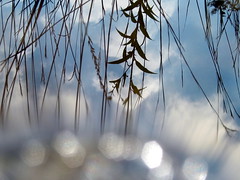Johannes Moser was the featured cellist with the Dvorák Cello Concerto. What a grand concerto this is: beginning with the full force of the orchestra in typical Dvorák style. The first movement is built around four notes that seem fitting for the Cello: dah dit dit dah is the best that I can describe it with words, the notes are woven all throughout. Mr Moser doesn't begin his solo part until about four minutes into the performance, and that's the way I like it because that beginning part by the orchestra is pure symphonic Dvorák, and builds the anticipation for the soloist.
The orchestra really shined in the first movement, but in the second movement, it was Mr Moser all the way. The soft tones from the cello were really quite enjoyable to hear and to experience. A friend and his father attended with me, and one of them thought the cello didn't project enough volume - perhaps the nature of this movement is indeed that way, but I could hear and delighted in the softness of the sound.
With the final movement, one reaction "my favorite movement by far. What genius it must have taken to have written this." Another: "it didn't seem as good as the first two movements." I'm certain that everyone has their own reactions. Mine, I thought it was a very good movement, there were some symphonic flourishes and some multi-string playing by the soloist that were really interesting.
 All in all, I'd say this is a wonderful concerto.
All in all, I'd say this is a wonderful concerto.If I back up just a bit, there were Viennese waltz and polka demonstrations provided by Arthur Murray Dance Studio in the Grand Lobby prior to the concert. Four couples volunteered, and were shown these dances by the two dancers as the rest of us looked on.
After intermission Manfred Honeck said: "Tonight it's been like a Thanksgiving, first we had a hearty meal, and now its time for lots of desert!" Of course he was describing the Waltzes and polkas by the Strauss Family about to begin. Desert is my favorite part of the meal, and so too is the music that the PSO played so wonderfully, beginning with the Overture to Die Fledermaus, one of my favorites!
Last year this concert was beautiful, yet this year it was so much more. First there are all the waltzes, they speak for themselves - if you've never experienced this music in person in a concert hall I implore you to do so - the live music is without compare. One of the selections this year was the "Little Chatterbox Polka" with children of PSO orchestra members playing musical ratchets - it was delightful.
This year the 'desert' was heaped with one added topping: soprano Rebecca Nelsen, with her beautiful voice, treated us to the laughing and singing and the joy of "Mein Herr Marquis" wearing a marvelous white dress; also in "Vilja", she introduced as: "one of the most beautiful pieces in operatic repertoire .. tells a beautiful but sad fairytale".
Later she performed with the PSO, "Spiel’ ich die Unschuld vom Lande" (Audition Song) - indeed her portrayal of three different personalities auditioning was marvelous, a country girl, a queen, and I didn't quite catch the last one.
When it seemed the concert was over, Rebecca Nelson appeared one more time with the lyrics "You may think its time to go, but I'm not done yet - oh no!" A fabulous song, I'm not sure the name, she danced back and forth on the stage, she exits one side, then immediately enters opposite, and voila: there must be two of her - what magic? Was this an understudy or a twin sister? It was fun!
She made one final encore appearance clothed in a beautiful green dress - as she danced and sang, she gave red and yellow roses to members of the audience. Indeed this was an entertaining evening.

Myself and my friend Miki (Miklos); photo taken by his dad, also Miklos




